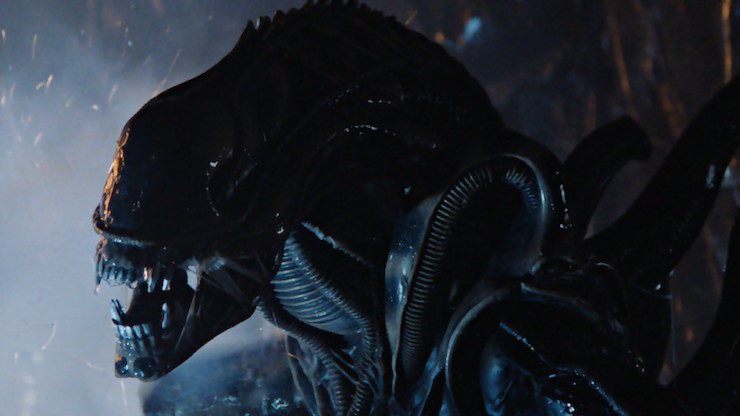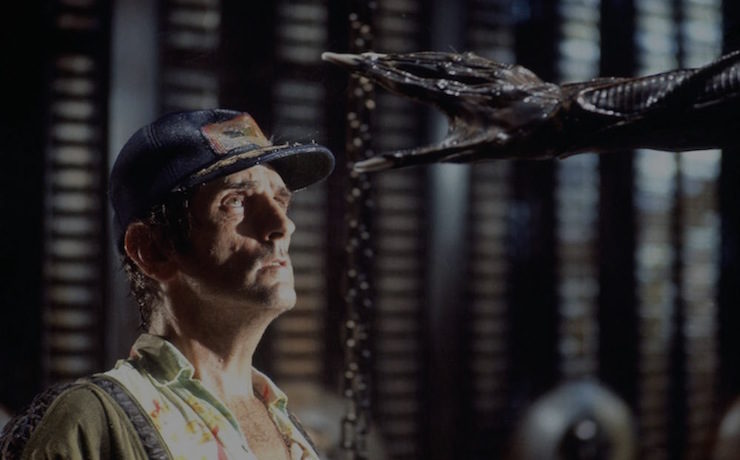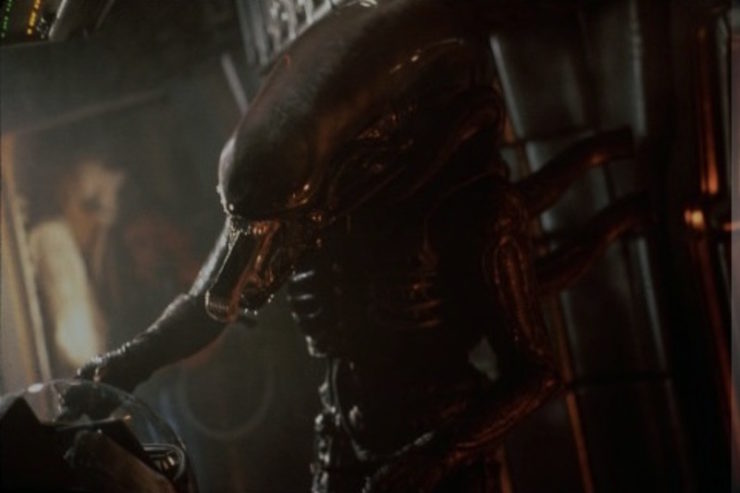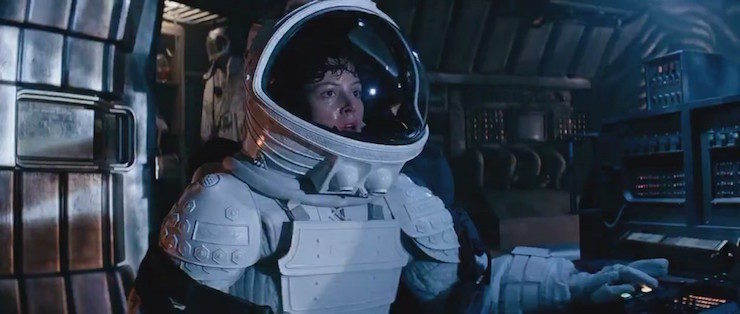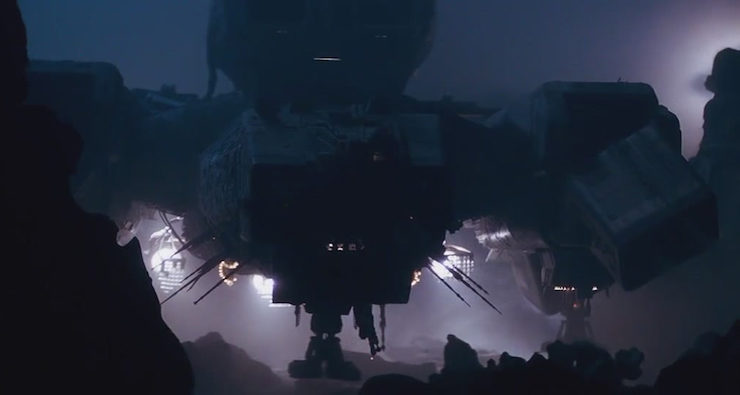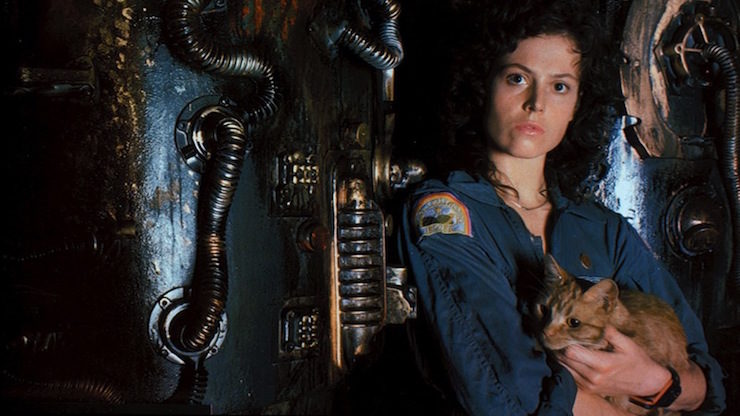I wish I could say I saw Alien on the big screen in 1979, and experienced the glory of Ridley Scott and H.R. Giger’s chest-bursting, face-hugging terrors before they became property of pop culture and parody. Alas, Alien was years before my time. The film was nearly thirty years old before I borrowed the DVD from a friend and watched it alone in a small, dark room. Mistake.
What my tiny, flickering television experience lacked in silver screen quality, it made up for in atmosphere, intense claustrophobia, and the eerie sense of being isolated in the universe. Space is already a terrifying, incomprehensible void to me; adding Alien’s Xenomorph only made me check my locks thrice and start looking up how to make homemade napalm… at least for fiction’s sake.
I watched the film countless times, breaking down the movie down into its basest parts, trying to understand why it succeeded to frighten audiences so thoroughly with its modest budget, low performance expectations, and a fairly lukewarm critical reception. Nowadays, the film is widely considered a classic.
Here’s what Alien taught me about writing horror.
Wait to Show Your (Entire) Hand
This rule applies to horror writers of any ilk: Once the audience manages to get a good look at the scare, it depreciates rapidly and forces the writer to fight a losing battle of diminishing returns. In Alien, Scott is careful to never let his audiences see the entire Xenomorph until the end—we see glimpses of the creature as a newborn, a hand here, a mouth there, but little else until the final showdown in the escape capsule. By that point, the reveal of the Xenomorph is not only necessary, but an integral part of the climax… and the scare.
I tend to think of this as the “new car principle” in horror—once you drive your shiny new monster off the lot, its value drops substantially and cannot be recouped.
The “Strange Form” Principle
A large part of Alien’s lasting appeal is Swiss artist H.R. Giger’s timeless, biomechanical design for the Xenomorph. I won’t spend much time delving into the symbolism of the creature—I’d like to keep this conversation family-friendly—except to point out that the word xenomorph is from the Greek words xeno, meaning “stranger or foreigner,” and morph, meaning “form.” Though the Xenomorph is alien, a “strange form,” its design still has humanoid elements: Bipedal, it walks upright on two feet and possesses two arms, shoulders, and a head (albeit an elongated one). Also note the lack of eyes, which makes the creature appear soulless, thus rendering the audience incapable of feeling empathy for the alien.
The inclusion of humanoid elements on a “strange form” creates a nice cognitive dissonance, too—there are limbs we recognize, organized in a shape that seems to insist upon intelligence, rationality even… but instead, the form embodies a chaotic savagery that shocks and terrifies the audience.
Lastly, to achieve a lasting psychological scare, writers can follow Geiger’s model and make their monsters embody both tangible and intangible fears. In Alien’s case, the tangible fear the Xenomorph presents is a gruesome, painful death; but it also represents the psychological horrors of rape. How so? For those of you who haven’t noticed the film’s symbolism, I’m just going to point to the Pilot Jockey. And the facehugger. And the shape of the chestburster. And the… well, you get the point.
Horror is Flexible
Ridley Scott famously called Alien “the Texas Chainsaw Massacre in space.” True to his pronouncement, the film shares most of its plot characteristics with the standard slasher, particularly in terms of “the Final Girl” trope. In fact, Scott says Ellen Ripley’s last stand in the starship Nostromo was influenced by Laurie Strode’s end battle with Michael Myers in Halloween (1978).
Simply defined, genre is often determined by the specific events that constitute a story’s plot; though the setting, roles characters assume, themes, and cultural values come into play as well. The great advantage horror storytellers have is the ability to step into a speculative world of their choosing and still tell a horror story. Horror meshes well with science fiction, fantasy (particularly urban fantasy), magical realism, steampunk, time-travel, contemporary fiction, crime novels… the list goes on. However, stories may only include horror elements as opposed to being defined specifically as horror projects.
Bet on Setting
An element Alien is renowned for is the gritty interior of the starship Nostromo. It gave audiences a dissonant view of space travel, located in a galaxy far, far away from the Empire’s bright, white hallways and pristine Stormtrooper armor. Alien tore preconceived notions of space travel apart, promptly filling the void with exposed metal, rustling chains, rusted pipes, stuttering lights, and an occasional shock of pure silence.
Alien’s deep space setting has the added bonus of being a completely inhospitable battleground. Settings in horror novels work double-duty, not only providing a backdrop for the action, but being an active obstacle that keeps the protagonists from escaping, surviving, being rescued, or otherwise achieving their goals.
When All Else Fails, Save the Cat
One of my favorite Ripley moments comes toward the end, when she’s living the dream as the Final Girl and banging down a corridor with a gun in one hand, a cat carrier in the other. It’s a horribly awkward way to try and escape the nightmare, and every time I watch the film, I always find myself chuckling because if I were in Ripley’s shoes, I realize I would be doing the exact same thing.
Creating an effective scare isn’t wholly dependent on the creation of a terrifying monster. Paradoxically, I have argued in the past that a storyteller can make any sort of creature frightening, so long as it (1) presents a clear mortal, spiritual, emotional, or psychological threat; and (2) the protagonist engages the audience’s empathy.
In Alien’s case, our empathy and regard for Ripley increases a thousand-fold when she chooses to save Jones the cat, a creature essentially incapable of saving itself from the Xenomorph or evacuating itself during the ship’s self-destruct sequence. Jones’ presence heightens the dramatic tension—we follow Ripley as she searches through the ship, calling for Jones under her breath, all the while trying to avoid the alien creature hunting her through the ship’s corridors.
Don’t kill the cat. Or the dog, for that matter—we’re horror writers here, not monsters.
This article was originally published in February 2015.
Courtney Alameda is a veteran bookseller and librarian. She holds a degree in English Literature with an emphasis in Creative Writing from Brigham Young University. Her debut novel Shutter is available from Feiwel & Friends. She lives in Salt Lake City, Utah. You can follow her on Twitter and visit her website.










